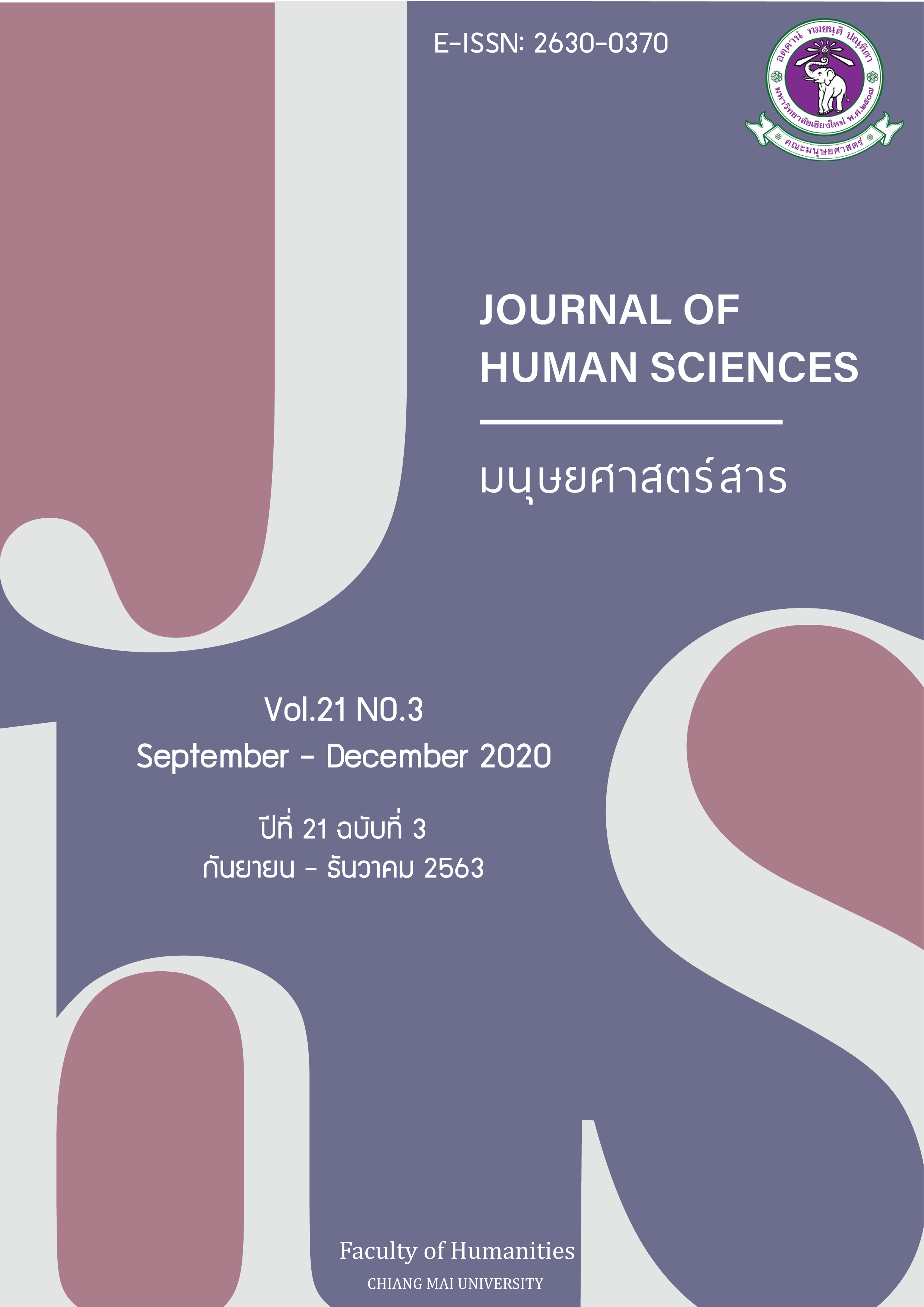ข้อสังเกตว่าด้วยพุทธศาสนาชนชั้นกลางไทย อำนาจแห่งกรรม และมโนทัศน์ศีล 5: จากรากฐาน สู่ ปรากฏการณ์ร่วมสมัย
Main Article Content
บทคัดย่อ
พุทธศาสนาของชนชั้นกลางไทยนับเป็นปรากฏการณ์ทางสังคมวัฒนธรรมใหม่ที่เพิ่งเกิดขึ้นมา ไม่ช่วงระยะเวลาไม่กี่ทศวรรษนี้ ข้อค้นพบผ่านการมองภาพกว้างในการศึกษา คือ พุทธศาสนาชนชั้นกลางไทยนั้นตั้งอยู่บนฐานคิดสำคัญ 2 เรื่อง คือ 1) ความเชื่อเรื่อง “อำนาจแห่งกรรม” ซึ่งเป็นค่านิยมหลักดั้งเดิมของไทยที่มีอิทธิพลครอบงำโลกทัศน์ชาวพุทธชนชั้นกลางไทยมาอย่างยาวนาน ซึมลึก และไม่เคยถูกท้าทายอย่าง ถึงรากทั้งยังถูกผลิตซ้ำและปรากฏตัวในที่ทางใหม่ผ่านสื่อประเภทต่างๆ กับ 2) “มโนทัศน์ ศีล 5” ซึ่งเป็นจริยธรรมชาวพุทธ (ใหม่) ที่ถูกใช้เป็นเกณฑ์ประเมินความเป็นชาวพุทธที่ดี และเป็นความรู้ทางธรรมในแบบที่รัฐและชนชั้นนำไทยพยายามฉีดป้อนสู่พลเมืองผ่านระบบการศึกษานับตั้งแต่สมัยสมบูรณาญาสิทธิราชย์ สิ่งนี้ มีอิทธิพลส่งผ่านมาถึงชนชั้นกลางไทยในเวลาต่อมา ทั้งนี้ การผสานแนวคิดเรื่อง “อำนาจแห่งกรรม” กับ มโนทัศน์ “ศีล 5” มีให้เห็นชัดเจนทั้งโดยกลุ่มชาวพุทธชนชั้นกลางสายนักปฏิบัติที่ให้ความสำคัญกับแนวคิด วิปัสสนากรรมฐานแก้กรรม บ้างเป็นทัศนะที่สะท้อนผ่านหนังสือธรรมมะที่เป็นงานเขียนระดับ “เบสเซลเลอร์” โดยผู้เขียนที่เป็นฆราวาส และบ้างสะท้อนผ่านทัศนะมุมมองของกลุ่มก้อนองค์กรชาวพุทธชนชั้นกลางไทย ใหม่ๆ ที่ปรากฏขึ้นในปัจจุบัน นอกจากนี้ อาจตั้งข้อสังเกตได้ถึงจริตของชาวพุทธชนชั้นกลางไทยเรื่องการให้ความสำคัญอย่างยิ่งยวดกับเรื่อง “พุทธแท้” “พุทธเทียม” ที่สามารถอธิบายสืบย้อนไปถึงที่มาได้
Article Details
เอกสารอ้างอิง
Anderson, B. (1977). Withdrawal Symptoms: Social and Cultural Aspect of the October 6 Coup. Bulletin of Concerned Asian Scholars. 9(3). 13-30.
Bangyikan, S. (2009) kao kham tham praden thi rao songsai kieokap phut satsana [9 questions about Buddhism.]. a day, 9(108).
Buaban, J. (2017) khrai khư phu kamnot phrưttikam thi mo̜som kho̜ng phra? [ Who sets Proper behavior of monks] Retrieved from https://prachatai.com/journal/2017/11/73914
Chansongseang, W. (2006). mokkhaphalaram: aram anpen kamlang pen kamlang hæng khwam lutphon [Mokkhaphalaram: Monastery of liberation]. Sarakadee, 22(225). 98-109.
Chanthornwong, S (2006). bot phichan waduai wannakam kanmưang læ prawattisat [Review of literature, politics and history]. Bangkok: Khobfai.
Chaturan, N. (n.d.). phuttholoyi luangpho̜ Charan son kan charœnphra kammathan duai satipattathan si [“Phuttholoyi” Reverend Father Charan teaches meditation by the Consciousness 4]. Bangkok: Phraphutsatsanaprakat.
Chuangsakun, S. (1993). khwam plianplæng kho̜ng khana song sưksa korani thammayutiknikai Pho.So. 2368 – 2464 [Changes of the clergy A case study of thammayut doctrine, 1825-1921]. Journal of Letters, 25(1-2). 44-73.
Dangtrin. (2004). siada khon tai mai daian (Phim khrang thi samsipet) [Sadly, the dead didn't read it (38th ed.)]. Bangkok: DMG.
Eaosriwong, N. (1984). pakkai læ bai rưa ruam khwam riang waduai wannakam læ prawattisat ton Rattanakosin [Pen and Sail: Literature and history of the early Rattanakosin period] Bangkok: Amarin.
Eaosriwong, N. (1993). watthanatham kho̜ng chon chan klang Thai [Culture of the Thai middle class]. Journal of Thammasat, 19(1). 31-41.
Kasi, P. (n.d.) chiwit likhit duai kam [Destined life with karma] Bangkok: Liengchaeng
Kittiarsa, P. (2012). Mediums, Monks, and Amulets: Thai Popular Buddhism Today. Bangkok: Silkworm.
McDaniel, J, (2011). The Lovelorn Ghost and The Magical Monk: Practicing Buddhism in Modern Thailand. NY: Columbia University Press.
Matcharoen, W. (1993). bæprian sangkhommasưksa kap kanklomklao thangkan mưang nai samai cho̜mphon sarit thanarat: sưksa korani khwammankhong kho̜ng sathaban chat satsana phra maha kasat [Social studies textbook with politicalization In the period of Field Marshal Sarit Thanarat]. Journal of Letters, 25(1-2). 91-107.
Phasuthanchat, P (2017). khrat læ khwinin [Solar eclipse and quinine]. Bangkok: Illumination Editions.
Phatthrakunwanit, C. (2016) satchaniyom mahatsachan nai ngan khong kabrian kasia maket, thoni mo̜risan læ wannakam Thai [Wondrous realism in the work of Gabriel Garcia Marquez, Toni Morrison And Thai literature]. Bangkok: An.
Phonkrit Narut Kanya. (2015). kœt mai sam mum num sao thi mung dœnna su thang nipphan [Reborn: three young people who desire nirvana]. Bangkok: Thankanphim
Photchanalawan, P. (2019). Thai pidok prawattisat kanmưang sangkhom ruamsamai khong phut satsana Thai [Thaipidok: Contemporary social and political history of Thai Buddhism.]. Bangkok: Illumination Editions.
Ratchakawee, N (2013). khwam chưa bæp phut Thai nai kan totan khommiunit Pho.So. songphanharoipæt - so̜ngphanharo̜isipkao [Thai Buddhist beliefs in anti-communism, 1965-1976 C.E.]. (Master of arts thesis, Thammasat University).
Saesow, R. (2006). rachan kot hæng kam [King of the karma]. n.p.
Sattayanurak, S. (2007). khưk rit kap praditthakam khwampen Thai lem song [Khukrit and The Thai invention Vol 2]. Bangkok: Mathichon.
Sivaraksa, S. (2004). phut satsana Thai læ prachathipatai Thai chak mummong khong So Sivaraksa [Thai Buddhism and Thai Democracy From the perspective of So Sivaraksa]. Bangkok: Siam.
Taylor, J.L. (1993). Forest Monks and the Nation – State: An Anthropological and Historical Study in Northeastern Thailand. Singapore: Institute of Asian Studies.
Thanomsasana, S. (2015). kan plianplæng thang khwamkhit khong chon chan klang Thai kap " rưang anlen" Thaisamaimai thotsawatso̜ngphansiroihoksip - thotsawat songphansiroipætsip [The Changing Perspective of the Thai Middle Class and Modern Thai Fictions Late 1910s-Late1940s]. (Dissertation, Chulalongkorn University).
Thaweesak, S. (2018). Phutthathat Phikkhu kap phut satsana bæp lok wisai [Phutthathat and the Secular Buddhism]. Pachanrayasan, 42(2). 52-72.
Uitekkheng, K. (2015). phut sat nai saiyasat [Buddhism in black magic]. Retrieved from https://www.youtube.com/watch?v=yDcJZzsaGzg
Wachirayanawarorot. (1983). wipatsana kammatthan wipanlatkatha læ phra ti lak kho Na katha [Meditation and Incantation details]. Bangkok: Mahamakutratwitthayalai.
Wantana, S. (1977). wannakam phut satsana bæp chaoban phicharana korani: kot hæng kam kho̜ng tor liangphibun [Buddhist literature, folklore, consider the case of the the krama of T.Liang Phibun]. Journal of Thammasat, 7(2). 82-101.
Wasi, P. (1987). suan mok thammakai santi asok [Three monasteries]. Bangkok: mo chaoban.
Winichakul, T. (1997). Siam Mapped: A History of the Geo-Body of a Nation. HI: University of Hawaii Pres.
Wongsakon, A. (2016). techo wipatsana . . . pœt pratu nipphan (Phim khrang thi hok) [Fire Meditation: Open the door of nirvana (6th ed.)]. Bangkok: Amarin.
Worawanno, P. (2017). phut mai la yom [Buddhist, Yom?]. Bangkok: Wara.


